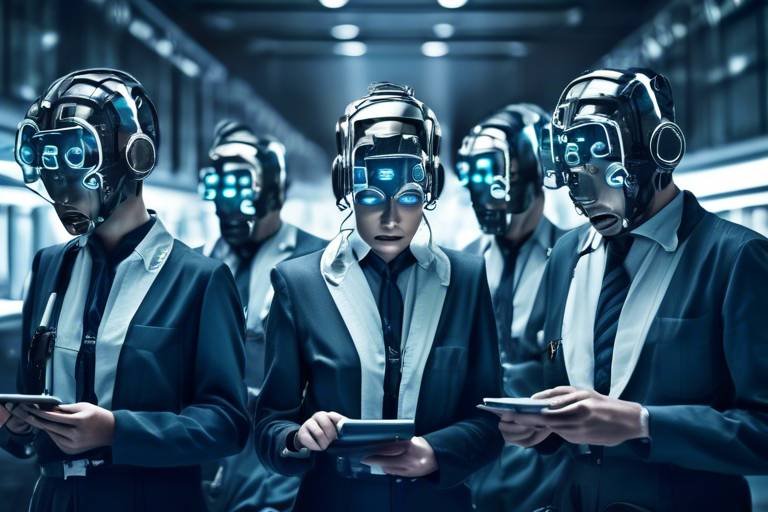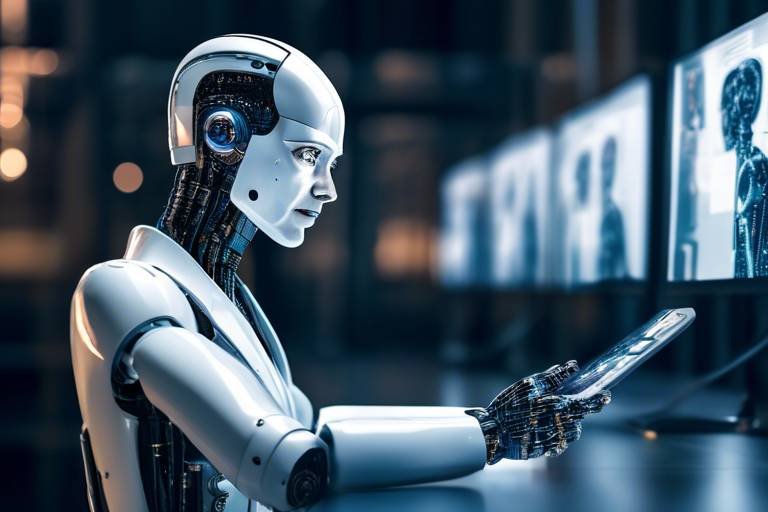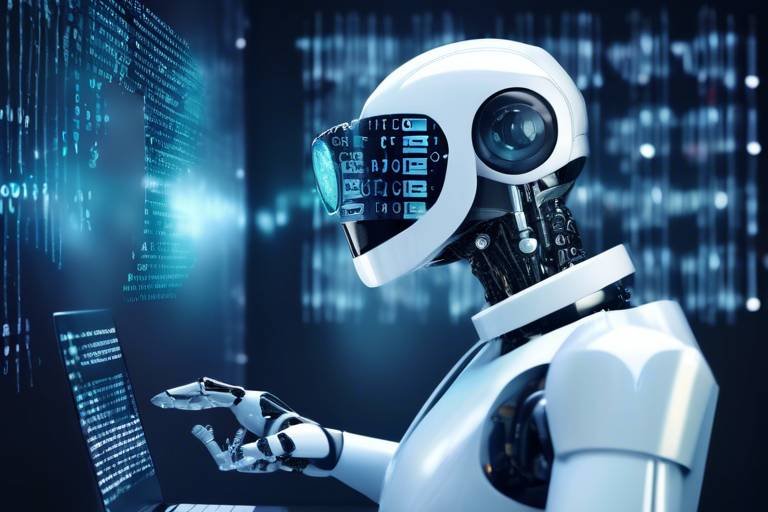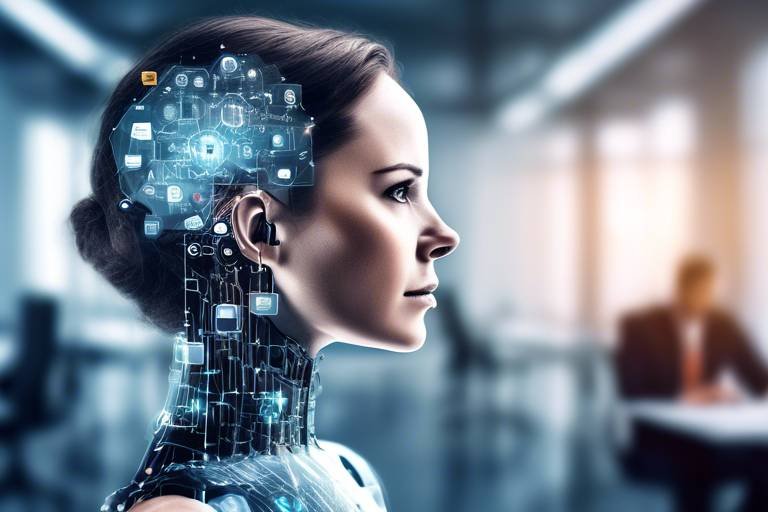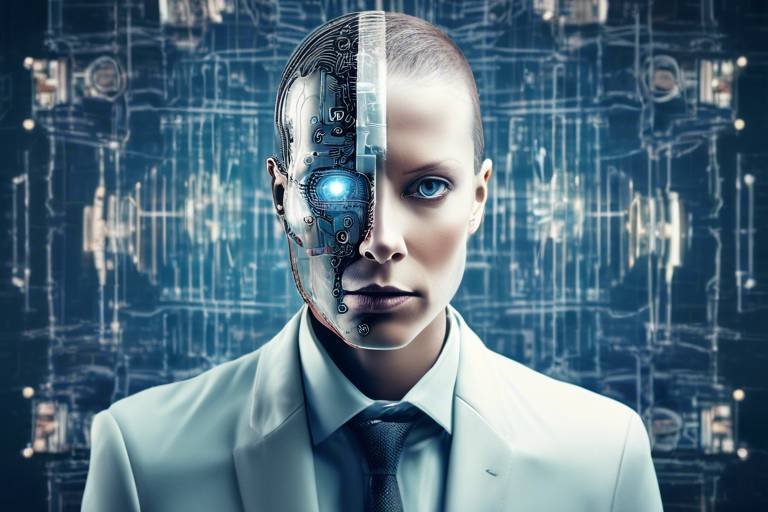Prospective Role of AI in Future Job Equality
As we stand on the brink of a technological revolution, the role of artificial intelligence (AI) in shaping job equality is becoming increasingly significant. Imagine a world where hiring decisions are made not based on biases but on pure merit. Sounds like a dream, right? Well, AI has the potential to turn this dream into reality. By analyzing vast amounts of data, AI can help identify the best candidates for a job, regardless of their background, gender, or ethnicity. This could lead to a more diverse and inclusive workforce, where everyone has a fair shot at success.
However, the journey toward achieving job equality through AI isn't without its bumps. While the technology promises to dismantle traditional barriers, it also brings forth challenges that we must address. For instance, the fear of job displacement looms large as automation takes over certain roles. Yet, it’s not all doom and gloom; AI also opens doors to new opportunities that we haven't even imagined yet. The key lies in understanding this dual impact and preparing our workforce to adapt.
As we dive deeper into this topic, we'll explore how AI can enhance workforce diversity, the importance of reskilling and upskilling, and the ethical considerations that come into play. So, buckle up! The future of job equality is an exciting ride, and AI is at the steering wheel.

AI and Workforce Diversity
In today's fast-paced world, the conversation around workforce diversity has gained unprecedented momentum, and artificial intelligence (AI) is emerging as a powerful ally in this quest. Imagine a workplace where individuals from all backgrounds, cultures, and experiences come together, creating a vibrant tapestry of ideas and perspectives. This is not just a dream; it's a potential reality that AI can help realize. By minimizing biases in hiring processes, AI has the ability to ensure that candidates from various backgrounds are considered equally, fostering a more inclusive work environment.
One of the most significant ways AI can enhance diversity is through its ability to analyze job descriptions and candidate resumes without the influence of human biases. Traditional hiring practices often suffer from unconscious biases, where factors like gender, ethnicity, or even the name on a resume can unfairly influence decisions. AI systems, when designed correctly, can sift through applications based solely on skills and qualifications, leveling the playing field for all candidates. This means that a talented individual from an underrepresented demographic can have the same chance of being hired as a more traditional candidate, which is a huge step towards equity in the workplace.
However, it's essential to recognize that the effectiveness of AI in promoting diversity hinges on how it is implemented. Without careful consideration, AI can inadvertently perpetuate existing biases. For instance, if an AI system is trained on historical hiring data that reflects biased decisions, it may continue to favor certain demographics over others. Therefore, organizations must ensure that their AI systems are designed with fairness in mind, incorporating diverse data sets and regular audits to check for bias.
Moreover, AI can also play a crucial role in creating a more inclusive corporate culture. By analyzing employee feedback and engagement data, AI can help identify areas where diversity initiatives may be lacking. For example, if AI tools reveal that certain groups feel less included in team activities or decision-making processes, organizations can take proactive steps to address these issues, ultimately leading to a more harmonious and productive work environment.
In conclusion, the integration of AI in hiring and workplace practices presents a remarkable opportunity to enhance workforce diversity. When implemented thoughtfully, AI can dismantle barriers that have historically hindered underrepresented groups from achieving equal representation in the workforce. However, it is imperative that organizations remain vigilant in monitoring AI systems to ensure they promote fairness and inclusivity. The future of work is not just about technology; it's about creating a workplace where everyone has a fair shot at success.

Impact on Job Creation
When we think about artificial intelligence, it's easy to get caught up in the fear of job loss. Sure, automation is a real concern, but let's not forget the flip side of the coin! AI isn't just about taking jobs away; it's also about creating new ones. Imagine a world where technology not only enhances our efficiency but also opens doors to roles we haven't even dreamed of yet. This dual impact is crucial for understanding the future landscape of work.
As AI continues to evolve, it brings with it a wave of opportunities that can reshape industries. For instance, consider the emergence of jobs in AI development, maintenance, and oversight. These roles require a unique set of skills that are currently in high demand. Companies will need data scientists, AI ethicists, and machine learning engineers to navigate this new terrain. Not only do these positions offer exciting career paths, but they also contribute to a more diverse job market.
However, the challenge lies in ensuring that the workforce is ready for these changes. As certain jobs become obsolete, we must focus on the reskilling and upskilling of employees. Organizations should invest in training programs that equip workers with the necessary skills to thrive in an AI-driven environment. This proactive approach not only safeguards jobs but also empowers individuals to embrace new opportunities.
To illustrate this point, let’s take a look at a hypothetical scenario. Imagine a factory where robots handle repetitive tasks. While some workers may fear losing their positions, others can transition into roles that involve overseeing these robots, troubleshooting issues, and optimizing production processes. This shift not only enhances the company's efficiency but also creates a more skilled workforce.
Moreover, AI can drive innovation, leading to the creation of entirely new industries. For example, the rise of autonomous vehicles has sparked demand for roles in safety regulation, vehicle software development, and infrastructure planning. These are not just jobs; they represent a shift in how we think about work and the skills we need to succeed.
In conclusion, while the concern over job displacement is valid, it’s essential to recognize the potential for job creation that AI brings. By fostering a culture of continuous learning and adaptation, we can prepare ourselves for the evolving job market. The key is to embrace change and drive forward with a mindset that sees opportunity rather than loss.
- Will AI really create new jobs? Yes, while AI may automate certain tasks, it also has the potential to create new roles that require human oversight and creativity.
- What types of jobs will be in demand due to AI? Roles in AI development, data analysis, and technology maintenance are expected to grow significantly as AI technologies advance.
- How can workers prepare for the changes brought by AI? Workers can prepare by engaging in reskilling and upskilling programs, focusing on acquiring new skills that align with the demands of an AI-driven market.
- Are there any industries that will benefit more from AI? Yes, industries such as healthcare, transportation, and manufacturing are likely to see significant benefits from AI integration.

Reskilling and Upskilling
As artificial intelligence (AI) continues to evolve at a breakneck pace, the need for reskilling and upskilling has never been more critical. Imagine a world where technology is not just a tool but a partner in our daily work. To thrive in this landscape, employees must adapt and enhance their skill sets to remain relevant. This is where reskilling and upskilling come into play, acting as lifelines for workers navigating the shifting tides of the job market.
Reskilling refers to the process of learning new skills to transition into a different job or role, while upskilling involves enhancing existing skills to improve performance in one’s current position. Both strategies are essential as AI automates routine tasks, making some jobs obsolete while simultaneously creating new opportunities in fields we can only begin to imagine. For instance, roles in AI maintenance, data analysis, and ethical AI governance are emerging as vital components of the future workforce.
Organizations that recognize the importance of investing in their employees’ development will not only foster loyalty but also enhance productivity. Companies can implement various training programs tailored to meet the specific needs of their workforce. These programs can take many forms, including:
- Workshops and Seminars: Interactive sessions that provide hands-on experience with new tools and technologies.
- Online Courses: Flexible learning options that employees can access at their convenience, covering a wide range of topics from coding to AI ethics.
- Mentorship Programs: Pairing experienced employees with those looking to develop new skills can create a culture of continuous learning.
Moreover, the responsibility for reskilling and upskilling does not rest solely on the shoulders of the employees. Organizations must take the initiative to create a supportive environment that encourages growth and adaptability. By fostering a culture of learning, companies can empower their employees to embrace change rather than fear it. This proactive approach can significantly reduce the anxiety associated with job displacement as workers feel equipped to tackle new challenges head-on.
Furthermore, collaboration between businesses and educational institutions can play a pivotal role in shaping a workforce that is prepared for the future. By aligning curricula with industry needs, educational programs can ensure that graduates possess the skills necessary to thrive in a job market increasingly dominated by AI and automation. This partnership can lead to a more robust pipeline of talent, ready to take on the challenges of tomorrow.
In conclusion, reskilling and upskilling are not just buzzwords; they are essential strategies for navigating the future job landscape. By embracing these practices, both employees and organizations can foster a more resilient and adaptable workforce, ready to seize the opportunities that AI presents. The future is bright for those who invest in their skills and commit to lifelong learning.
Q1: What is the difference between reskilling and upskilling?
A1: Reskilling involves learning new skills for a different job, while upskilling focuses on enhancing existing skills to improve performance in the current role.
Q2: Why is reskilling important in the age of AI?
A2: Reskilling is crucial as AI automates many tasks, leading to job displacement. By reskilling, workers can transition into new roles that emerge as technology evolves.
Q3: How can organizations support reskilling efforts?
A3: Organizations can support reskilling by offering training programs, workshops, and mentorship opportunities, creating a culture that values continuous learning.
Q4: What role do educational institutions play in reskilling?
A4: Educational institutions can align their curricula with industry needs, ensuring that graduates possess the relevant skills to succeed in an AI-driven job market.

Training Programs for AI Adoption
As we stand on the brink of a technological revolution, the importance of cannot be overstated. These programs are not merely a luxury; they are a necessity for both organizations and employees. Imagine walking into a workplace where the tools you once used have been replaced by advanced AI systems. Without proper training, it can feel like stepping into a foreign land where you don’t speak the language. This is why investing in comprehensive training initiatives is essential.
Effective training programs should be designed to cater to a wide range of skill levels and learning styles. They should encompass not only the technical aspects of AI but also the soft skills that enhance collaboration and innovation. A robust training program typically includes:
- Hands-on Workshops: These sessions allow employees to interact directly with AI tools, fostering a deeper understanding of their functionalities.
- Online Courses: Flexible online learning platforms can provide employees with access to a wealth of resources, enabling them to learn at their own pace.
- Mentorship Programs: Pairing less experienced employees with AI experts can facilitate knowledge transfer and practical insights.
Moreover, organizations must promote a culture of continuous learning. This means encouraging employees to engage with ongoing training and development opportunities even after the initial adoption phase. Just like a plant needs regular watering to thrive, employees need consistent upskilling to keep pace with the rapidly evolving AI landscape. Companies can create an environment of growth by:
- Offering incentives for completing training programs.
- Creating internal knowledge-sharing platforms.
- Regularly updating training materials to reflect the latest advancements in AI technology.
Additionally, organizations should consider partnering with educational institutions and tech companies to enhance their training offerings. By collaborating with experts in the field, companies can ensure that their training programs remain relevant and effective. This collaboration can take many forms, such as guest lectures, collaborative projects, or even co-developing specialized courses tailored to specific industry needs.
Ultimately, the goal of these training programs is to empower employees, making them feel confident and capable in their roles. As AI systems become more integrated into daily operations, employees equipped with the right skills will not only adapt more quickly but also contribute to a more innovative and productive work environment. In essence, investing in training programs for AI adoption is not just about keeping up with technology; it’s about creating a workforce that is ready to thrive in the future.
Q1: Why are training programs for AI adoption important?
A1: Training programs are crucial as they equip employees with the necessary skills to navigate AI technologies effectively, ensuring they can leverage these tools for enhanced productivity and innovation.
Q2: What types of training methods are most effective?
A2: A combination of hands-on workshops, online courses, and mentorship programs tends to be the most effective approach, as it caters to various learning styles and promotes continuous development.
Q3: How can organizations promote a culture of continuous learning?
A3: Organizations can encourage continuous learning by offering incentives for training completion, creating internal knowledge-sharing platforms, and regularly updating training materials.
Q4: Can companies collaborate with educational institutions for training?
A4: Yes, partnering with educational institutions and tech companies can enhance training offerings, ensuring they remain relevant and effective in the fast-evolving AI landscape.

Government Initiatives
In the rapidly evolving landscape shaped by artificial intelligence, play a pivotal role in ensuring that workers are not left behind. As AI technologies advance, the potential for job displacement grows, making it essential for governments to step in and facilitate a smooth transition for the workforce. This involves not just funding and support but also creating a framework that encourages continuous learning and adaptation. For instance, many governments are launching programs aimed at enhancing digital literacy, which is crucial for employees to thrive in an AI-driven job market.
One of the most effective strategies involves the establishment of partnerships between the public and private sectors. By collaborating with tech companies and educational institutions, governments can develop tailored training programs that meet the specific needs of the job market. These partnerships can lead to the creation of community-based training centers, which provide accessible resources for individuals looking to upskill or reskill. Such initiatives not only empower workers but also help bridge the skills gap that AI technologies can exacerbate.
Moreover, government initiatives often include financial incentives for companies that invest in employee training. This approach encourages businesses to take an active role in the development of their workforce, fostering a culture of learning and adaptability. For example, tax credits or grants can be offered to organizations that implement robust training programs, thereby alleviating some of the financial burdens associated with employee development.
To illustrate the impact of these initiatives, consider the following table that outlines some key government programs aimed at promoting reskilling:
| Program Name | Description | Target Audience |
|---|---|---|
| Digital Skills Initiative | A nationwide program aimed at enhancing digital literacy among workers. | All employees, particularly those in low-tech industries. |
| Tech Training Grants | Financial support for companies that provide training in AI and related technologies. | Small to medium-sized enterprises (SMEs). |
| Workforce Development Fund | Funding for community colleges to develop programs tailored to local job markets. | Job seekers and underemployed individuals. |
In addition to these programs, governments are increasingly focusing on equitable access to training resources. This means ensuring that marginalized communities, who often face barriers to education and employment, have the opportunity to participate in reskilling initiatives. By prioritizing inclusivity, governments can help create a more balanced workforce that reflects the diverse society we live in.
Ultimately, the success of these government initiatives hinges on a collaborative approach that engages all stakeholders—workers, employers, and educational institutions. As we look to the future, it’s clear that proactive measures are essential for navigating the challenges posed by AI. By investing in our workforce today, we can pave the way for a more equitable and prosperous tomorrow.
- What are government initiatives in AI? Government initiatives in AI refer to programs and policies designed to support workforce development, reskilling, and equitable access to training in response to the changes brought about by artificial intelligence.
- How can I benefit from government training programs? Individuals can benefit from government training programs by gaining new skills that are relevant to the job market, increasing their employability, and adapting to the demands of an AI-driven economy.
- Are there specific programs for marginalized communities? Yes, many government initiatives prioritize equitable access, offering targeted programs and resources for marginalized communities to ensure they have the opportunity to participate in reskilling efforts.

Addressing Job Displacement
As we dive deeper into the era of artificial intelligence (AI), one of the most pressing concerns that emerges is **job displacement**. The reality is that while AI can enhance efficiency and productivity, it can also lead to the automation of many roles that have traditionally been filled by human workers. This situation creates a paradox: how can we embrace technological advancements while ensuring that individuals whose jobs are at risk are not left behind? It's a question that requires innovative thinking and proactive measures.
To effectively address job displacement, we must first understand the sectors most vulnerable to automation. For instance, roles in manufacturing, data entry, and even customer service are increasingly being taken over by AI technologies. However, it's not all doom and gloom. History has shown us that while some jobs may vanish, new ones often emerge in their place. The key lies in how we prepare our workforce for this transition.
Organizations and governments need to collaborate to create robust strategies that focus on **reskilling** and **upskilling** the workforce. This means developing training programs tailored to equip workers with skills that are in demand in the AI-driven job market. For example, consider the following approaches:
- Industry Partnerships: Collaborating with tech companies to design training programs that reflect current industry needs.
- Accessible Learning Platforms: Offering online courses that allow workers to learn at their own pace, making education more accessible to everyone.
- Mentorship Programs: Pairing displaced workers with mentors in growing fields to provide guidance and support during their career transitions.
Moreover, companies should not only focus on the immediate needs of their workforce but also anticipate future trends. This foresight can lead to the development of **cross-functional skills** that make employees adaptable and versatile. For instance, a worker in a manufacturing role might benefit from learning about AI systems, data analysis, or even project management, thus opening up new career paths. The more diverse a worker's skill set, the better equipped they are to navigate the evolving job landscape.
Another essential aspect of addressing job displacement is the role of **government initiatives**. Policymakers must step in to provide support for displaced workers through various means, such as funding for training programs, tax incentives for companies that invest in employee education, and creating safety nets for those who find themselves out of work. By fostering an environment where workers can easily transition into new roles, we can mitigate the negative impacts of job displacement.
In conclusion, addressing job displacement in the age of AI is not just about managing the loss of jobs; it's about embracing change and ensuring that our workforce is equipped to thrive in a new economy. By investing in reskilling and upskilling initiatives, fostering industry partnerships, and implementing supportive government policies, we can create a future where technological advancements benefit everyone, rather than leaving anyone behind.
- What types of jobs are most at risk of being automated? Jobs that involve repetitive tasks, such as data entry and manufacturing roles, are most vulnerable to automation.
- How can I prepare for potential job displacement? Upskilling and reskilling are key. Look for training programs that focus on in-demand skills in your industry.
- What role do governments play in addressing job displacement? Governments can provide funding for training programs and create policies that support displaced workers in transitioning to new jobs.

Ethical Considerations in AI
The integration of artificial intelligence into the workplace isn't just a matter of efficiency and productivity; it also raises significant ethical questions that we must confront. As AI systems become more prevalent, we must ensure that they are designed and implemented in ways that promote fairness and transparency. This is essential not only for building trust among employees but also for ensuring that everyone is treated equitably. After all, who wants to work in an environment where decisions are made by an opaque algorithm that may have biases we can't see?
One of the primary ethical concerns revolves around bias in AI algorithms. If AI systems are trained on historical data that reflects existing prejudices, they can inadvertently perpetuate those biases. For instance, if an AI recruitment tool is trained on data from a company that has historically favored certain demographics, it may continue to favor those groups in future hiring decisions. This can lead to a lack of diversity and an unfair disadvantage for qualified candidates from underrepresented backgrounds. To combat this, organizations must implement rigorous measures to ensure that their AI systems are designed with fairness in mind. Regular audits and updates to the algorithms can help identify and mitigate bias, creating a more equitable hiring process.
Another critical aspect is the need for transparency and accountability in AI decision-making processes. Employees and candidates should have a clear understanding of how AI systems operate and the criteria they use to make decisions. This transparency is vital for fostering trust within the workplace. Imagine applying for a job and receiving a rejection without any explanation. It can feel arbitrary and disheartening. By providing insights into how decisions are made, organizations can help demystify AI and reassure employees that they are being treated fairly. Furthermore, establishing accountability mechanisms ensures that organizations are held responsible for the outcomes of their AI systems. If an AI tool leads to discriminatory practices, there should be clear pathways for addressing and rectifying those issues.
In light of these considerations, organizations should also engage in open dialogues with their employees about the role of AI in their work. This can include workshops, feedback sessions, and ongoing training that empower employees to voice their concerns and suggestions regarding AI implementations. By creating an inclusive environment where employees feel their opinions matter, organizations can better navigate the ethical landscape of AI adoption.
Ultimately, the goal is to harness the potential of AI while ensuring that it serves as a tool for positive change. By addressing ethical considerations proactively, we can create a workplace where technology enhances job equality rather than detracting from it. As we move forward, it’s essential to keep the conversation going, ensuring that ethical considerations remain at the forefront of AI development and deployment.
- What are the main ethical concerns related to AI? The primary concerns include bias in algorithms, transparency in decision-making, and accountability for AI outcomes.
- How can organizations mitigate bias in AI? Organizations can mitigate bias by conducting regular audits of their AI systems, ensuring diverse training data, and implementing fairness measures in algorithm design.
- Why is transparency important in AI? Transparency helps build trust among employees and candidates, ensuring that they understand how decisions are made and that they are treated fairly.
- What role do employees play in addressing ethical AI concerns? Employees should be encouraged to voice their concerns and participate in discussions about AI implementations, fostering an inclusive environment.

Bias in AI Algorithms
As we delve into the realm of artificial intelligence, one of the most pressing issues that emerges is the bias inherent in AI algorithms. These biases can stem from various sources, including the data used to train these systems, the design of the algorithms themselves, and even the intentions of the developers. Imagine a world where the very technology designed to enhance fairness and efficiency in the workplace inadvertently perpetuates inequality. This is not just a hypothetical scenario; it's a reality we must confront.
AI systems are often trained on historical data, which can reflect past prejudices and systemic inequalities. For instance, if an AI is trained on hiring data from a company that has historically favored certain demographics, it may continue to favor those groups in its future hiring recommendations. This can lead to a cycle of discrimination where certain candidates are overlooked purely based on their background, not their qualifications. It's like trying to navigate a maze where the walls are built from outdated social norms—no matter how skilled you are, you might find yourself stuck.
To combat this issue, organizations must take a proactive approach. Here are a few strategies that can help:
- Diverse Data Sets: Ensuring that the data used to train AI systems is diverse and representative of all demographics can help mitigate bias.
- Regular Audits: Conducting regular audits of AI algorithms to assess their impact on different groups can help identify and rectify biases.
- Inclusive Development Teams: Building teams that are diverse in terms of gender, ethnicity, and experience can lead to more equitable AI solutions.
Moreover, transparency in the development and deployment of AI algorithms is crucial. Stakeholders should be aware of how decisions are made and the factors that influence these decisions. This is not just about ethical responsibility; it's also about building trust with employees and candidates alike. When people understand the mechanisms behind AI, they are more likely to accept its outcomes, even when those outcomes are not in their favor.
In conclusion, addressing bias in AI algorithms is not merely a technical challenge; it is a moral imperative. As we continue to integrate AI into our workplaces, we must remain vigilant and committed to fostering an environment where everyone has an equal opportunity to succeed. The future of work should not just be efficient and profitable; it should also be fair and just.
Q1: What causes bias in AI algorithms?
A1: Bias in AI can arise from unrepresentative training data, flawed algorithm design, or the personal biases of developers.
Q2: How can organizations reduce bias in AI?
A2: Organizations can reduce bias by using diverse data sets, conducting regular audits, and fostering inclusive development teams.
Q3: Why is transparency important in AI?
A3: Transparency helps build trust and ensures accountability in AI decision-making processes, making it easier to identify and correct biases.

Transparency and Accountability
In the rapidly evolving landscape of artificial intelligence (AI), the concepts of transparency and accountability are more crucial than ever. As organizations increasingly rely on AI systems for decision-making, it is essential to ensure that these systems operate in a manner that is both understandable and fair. Imagine a workplace where decisions about hiring, promotions, and even layoffs are made by an invisible algorithm. How can employees trust that these decisions are made without bias or error? This is where transparency comes into play.
Transparency in AI means that the processes and criteria used by these systems are open and accessible to scrutiny. For instance, if an AI system is responsible for screening job applications, candidates should have a clear understanding of how their applications are evaluated. This not only builds trust among employees but also helps organizations identify and rectify any biases that may exist within the algorithms. To put it simply, if you can’t see how the sausage is made, how can you be sure it’s not rotten?
Moreover, accountability is equally vital. Organizations must take responsibility for the outcomes produced by their AI systems. This means that there should be mechanisms in place to monitor and evaluate the performance of these systems regularly. If an AI system inadvertently discriminates against a particular demographic, there should be clear protocols for addressing the issue and compensating affected individuals. In this way, companies can foster a culture of responsibility and ethics, ensuring that all employees feel valued and protected.
To illustrate the importance of these principles, consider the following table that outlines key aspects of transparency and accountability in AI:
| Aspect | Description | Importance |
|---|---|---|
| Transparency | Open access to AI processes and decision-making criteria. | Builds trust and allows for the identification of biases. |
| Accountability | Responsibility for outcomes produced by AI systems. | Ensures ethical practices and employee protection. |
| Regular Audits | Systematic evaluations of AI performance. | Helps maintain fairness and effectiveness in decision-making. |
In conclusion, as we embrace the future of work shaped by AI, it is imperative that organizations prioritize transparency and accountability. By doing so, they not only enhance trust among employees but also ensure that AI serves as a tool for equity rather than a barrier to it. After all, in a world where machines are making more decisions, we must ensure that those decisions are made with the utmost integrity and fairness.
- What is transparency in AI? Transparency in AI refers to the openness of AI processes, allowing individuals to understand how decisions are made.
- Why is accountability important in AI? Accountability ensures that organizations take responsibility for the outcomes of their AI systems, fostering ethical practices.
- How can organizations ensure their AI systems are fair? Regular audits and evaluations can help identify biases in AI systems, ensuring fair treatment of all employees.
Frequently Asked Questions
- How can AI contribute to workforce diversity?
AI can play a significant role in enhancing workforce diversity by reducing biases in hiring processes. By analyzing candidate qualifications without the influence of personal characteristics such as race, gender, or age, AI ensures that a wider range of candidates from diverse backgrounds are considered for positions, leading to a more inclusive work environment.
- Will AI lead to job loss or job creation?
While it's true that AI may automate certain roles, it also has the potential to create new job opportunities. The key is to understand this dual impact. As technology evolves, new industries and roles will emerge, requiring a workforce that is adaptable and skilled in using AI tools.
- What is the importance of reskilling and upskilling in the age of AI?
Reskilling and upskilling are crucial for employees to remain relevant in an AI-driven job market. Organizations must invest in training programs that help workers adapt to new technologies and methodologies, ensuring not only their job security but also their growth in an ever-changing landscape.
- How can training programs facilitate AI adoption?
Effective training programs equip workers with the knowledge and skills needed to leverage AI technologies in their roles. By focusing on practical applications, these programs can boost productivity and foster innovation, ultimately benefiting both employees and organizations.
- What role do governments play in promoting reskilling initiatives?
Governments are essential in supporting reskilling initiatives by providing funding, resources, and programs aimed at helping workers transition into AI-driven job markets. Their involvement ensures equitable access to training resources, making it easier for everyone to adapt to new job demands.
- What strategies can address job displacement caused by AI?
To tackle job displacement, strategies such as developing safety nets for affected workers, offering career counseling, and promoting job creation in emerging sectors are vital. By fostering an environment that encourages continuous learning and adaptability, we can help workers find new opportunities in the evolving job landscape.
- What ethical considerations should be addressed with AI in the workplace?
Integrating AI into the workplace raises important ethical questions regarding fairness, transparency, and accountability. It's essential to ensure that AI systems are designed to promote equality and that their impacts on job equality are regularly assessed to build trust among employees.
- How can biases in AI algorithms be mitigated?
To prevent AI systems from perpetuating existing biases, it is crucial to implement measures that ensure fairness in their design and operation. This includes diversifying training data, regularly auditing algorithms for bias, and involving diverse teams in the development process.
- Why is transparency important in AI decision-making?
Transparency in AI decision-making processes is vital for accountability. Organizations must ensure that AI systems are understandable and that employees are aware of how decisions affecting their roles are made. This openness fosters trust and ensures equitable treatment for all workers.



